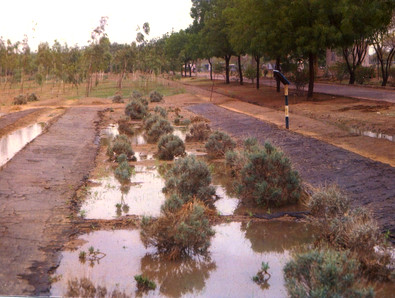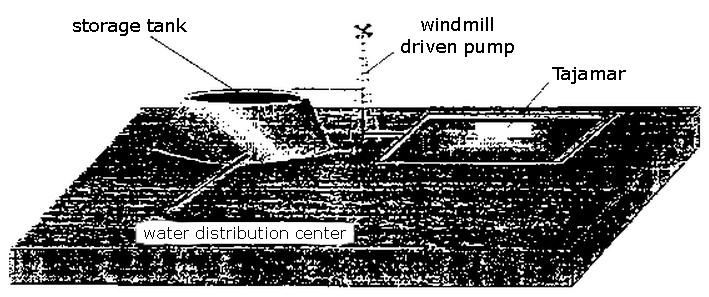Difference between revisions of "वाटर पोर्टल / वर्षाजल संचयन / यथास्थान वर्षाजल संचयन"
(Created page with "{{Language-box|english_link=Water Portal / Rainwater Harvesting / In situ rainwater harvesting | french_link=La collecte des eaux de pluie in situ | spanish_link=Coming soon |...") |
(No difference)
|
Revision as of 14:25, 28 November 2015
| |
|
|
|
|
|
|
|
|

In arid and semi-arid regions, where precipitation is low or infrequent during the dry season, it is necessary to store the maximum amount of rainwater during the wet season for use at a later time, especially for agricultural and domestic water supply. One of the methods frequently used in rainwater harvesting is the storage of rainwater in situ. Topographically low areas are ideal sites for in situ harvesting of rainfall. This technique has been used in the arid and semi-arid regions of northeastern Brazil, Argentina, and Paraguay, primarily for irrigation purposes. The in situ technology consists of making storage available in areas where the water is going to be utilized.
Generally this technology is simple and easy to use. Governmental organizations and the agricultural community generally work together to support and promote the in situ rainwater storage. Educational and information programs should be provided to inform users of the benefits of this technology, and the means of implementing rainwater harvesting while preventing soil loss.
Contents
Suitable conditions
This technology increases water supply for irrigation purposes in arid and semi-arid regions. It promotes improved management practices in the cultivation of corn, cotton, sorghum, and many other crops. It also provides additional water supply for livestock watering and domestic consumption.
In situ is applicable to low topographic areas in arid or semi-arid climates.
Extensive use is found in northeastern Brazil, in the Chaco region of Paraguay, and in Argentina. It can be used to augment the water supply for crops, livestock, and domestic use. With the mechanization of agriculture, its use has diminished, but it is still recommended for regions where the volume of rainfall is small and variable. The approach used depends primarily on the availability of equipment, the nature of the agricultural and livestock practices, and the type of soil.
Cultural Acceptability
In situ rainfall harvesting has been practiced for many years by the agricultural communities of northeastern Brazil, Paraguay, and Argentina. Agricultural communities in other arid and semi-arid regions can readily improve their level of irrigation and increase their production yield using this technique.
| Advantages | Disadvantages |
|---|---|
| - This technology requires minimal additional labor. - It offers flexibility of implementation; furrows can be constructed before or after planting. |
- In situ rainwater harvesting cannot be implemented where the slope of the land is greater than 5%. - It is difficult to implement in rocky soils. |
Design & construction
All rainfall harvesting systems have three components: a collection area, a conveyance system, and a storage area. In this application, collection and storage is provided within the landscape. Topographic depressions represent ideal collection and storage areas. In many situations, such areas are impermeable, being underlain by clay soils that minimize infiltration. Methods of rainwater harvesting in situ, including site preparation of agricultural areas in Brazil, are described below.
Use of Topographic Depressions as Rainfall Harvesting Areas
In Paraguay, areas of low topography used for rainwater storage are known as tajamares. Tajamares are constructed in areas with clay soils at least 3 m deep. The tajamares are served by distribution canals that convey water from the storage area to the areas of use. The collection and storage areas need to be fenced to avoid contamination by animals. This technology is usually combined with storage tanks built of clay. The water is delivered from the in situ rainfall collection area to the storage tank by means of a pump, usually driven by a windmill, as shown in Figure 1.
Water stored in tajamares is normally used for livestock watering and may be used for domestic consumption after filtration and/or chlorination. Individual tajamares have also been used as a means of artificially recharging groundwater aquifers. Tajamares built in the Paraguayan Chaco have produced up to 6 800 m3/yr for aquifer recharge.
Use of Furrows as Rainwater Storage Areas

Furrows may be used as an in situ means of storing harvested rainwater. They are built prior to or after planting to store water for future use by the plants. A variation on the use of topographic depressions to store rainfall, this method uses flattened trenches between the rows of crops to store water. Furrows may have mud dams or barriers every 2 m to 3 m along the row in order to retain water for longer periods of time and avoid excessive surface runoff and erosion. Raised beds may also be used to trap the water in the furrows, or uncultivated areas may be left between rows, spaced at 1 m apart, to assist in capturing rainwater falling on the land surface between furrows.
The Guimarães Duque
The Guimarães Duque method was developed in Brazil during the 1950s, and uses furrows and raised planting beds, on which cross cuts to retain water are made using a reversible disk plow with at least three disks. The furrows are usually placed at the edge of the cultivation zone.
Costs, operation & maintenance
This technology requires very little maintenance once the site is chosen and prepared. Maintenance is done primarily during the course of normal, day-to-day agricultural activities, and consists primarily of keeping the collection area free of debris and unwanted vegetation. Where only parts of the rows are cultivated, rotating the areas that are plowed will enable more efficient maintenance of the available storage area.
The costs of in situ rainwater collection systems are minimal. The main cost of this technology is in the equipment and labor required to build the fences and furrows. Table 1 shows representative costs reported for different methods of site preparation in cultivated areas of Brazil. Further, the construction cost of a tajamar in Paraguay has been reported at $4,500. This cost includes not only the cost of soil preparation, but also the cost of ancillary equipment such as the storage tank and windmill shown in the set up in Figure 1.
Table 1. Estimated Cost ($) of Different Site Preparation Methods for Rainwater Collection Areas in Agricultural Areas of Brazil.
| Method | Basic Equipment | Animal Traction | Total | Hourly Cost of Implementation |
|---|---|---|---|---|
| Flat terrain trenches | 150.00 | 300.00 | 450.00 | 0.96 |
| Post-planting furrows | 80.00 | 300.00 | 380.00 | 0.90 |
| Pre-planting furrows | 180.00 | 70.00 | 250.00 | 0.90 |
| Furrows with barriers | 180.00 | 70.00 | 250.00 | 0.90 |
| Inclined raised beds | 1,500.00 | 1,000.00 | 2,500.00 | 12-15 |
| Furrows in partial areas | 100.00 | 80.00 | 180.00 | 0.70 |
| Guimarães Duque method | ... | ... | ... | 12-15 |
Further Development of the Technology
The equipment used in the construction of the furrows and storage areas must be improved. Relatively inexpensive plows and tractors can reduce the cost of implementation and contribute to the more widespread use of this technology by small farmers. New methods of soil conservation should be explored.
Manuals, videos, and links
Contacts
- José Barbosa dos Anjos, Empresa Brasileira de Pesquisa Agropecuaria (EMBRAPA), Centro de Pesquisa Agropecuaria do Trópico Semi-Árido (CPATSA), BR-428 km 152, Zona Rural, Caixa Postal 23, 56300-000 Petrolina, Pernambuco, Brasil. Tel. (55-81)862-1711. Fax (55-81)862-1744. E-mail: [email protected].
- Everaldo Rocha Porto, Empresa Brasileira de Pesquisa Agropecuaria (EMBRAPA), Centro de Pesquisa Agropecuaria do Trópico Semi-Árido (CPATSA), BR-428 km 152, Zona Rural, Caixa Postal 23, 56300-000 Petrolina, Pernambuco, Brasil. Tel. (55-81)862-1711. Fax (55-81)862-1744. E-mail: [email protected].
- Luiza Teixeira de Lima Brito, Empresa Brasileira de Pesquisa Agropecuaria (EMBRAPA), Centro de Pesquisa Agropecuaria do Trópico Semi-Árido (CPATSA), BR-428 km 152, Zona Rural, Caixa Postal 23, 56300-000 Petrolina, Pernambuco, Brasil. Tel. (55-81)862-1711. Fax (55-81)862-1744. E-mail: [email protected].
- Eduardo Torres, Instituto Argentino de Investigaciones de las Zonas Aridas (IADIZA), Dependiente del Consejo Nacional de Ciencia y Tecnologia (CONICET), Universidad Nacional de Cuyo y Gobierno de la Provincia de Mendoza, Casilla de Correo 507, 5500 Mendoza, República Argentina. Fax (54-61)287955.
- Maria Sonia Lopes da Silva, Empresa Brasileira de Pesquisa Agropecuaria (EMBRAPA), Centro de Pesquisa Agropecuaria do Trópico Semi-Árido (CPATSA), BR-428 km 152, Zona Rural, Caixa Postal 23, 56300-000 Petrolina, Pernambuco, Brasil. Tel. (55-81)862-1711. Fax (55-81)862-1744. E-mail: [email protected].
- Aderaldo de Souza Silva, Empresa Brasileira de Pesquisa Agropecuaria (EMBRAPA), Centro Nacional de Pesquisa de Monitoramento e Avaliacao de Impacto Ambientalt (NPMA), Rodovia SP-340 km 127.5, Bairro Tanquinho Velho, Caixa Postal 69, 13820-000 Jaguariuna, São Paulo, Brasil. Tel.(55-4198)67-5633. Fax (55-4198)67-5225.
- Large wiki on water use for agriculture: Agropedia
Acknowledgements
Source Book of Alternative Technologies for Freshwater Augmentation in Latin America and the Caribbean. 1.2 Rainwater harvesting in situ. UNEP - International Environmental Technology Centre United Nations Environment Programme. Unit of Sustainable Development and Environment General Secretariat, Organization of American States, Washington, D.C., 1997.

